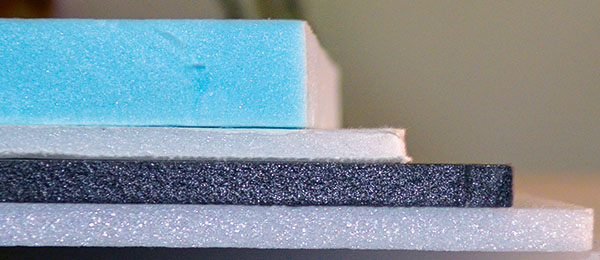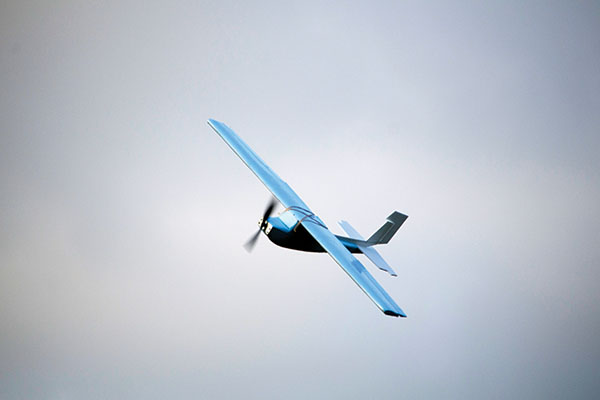
Written by Lucas Weakley Using foam to build airplanes New Technology As seen in the Summer 2018 issue of Park Pilot.
One of the questions I am asked the most from my videos and articles is, “What foam do you use for your builds?”

Here is a close-up of the foams discussed in the text. From top to bottom: BlueCor, Readi-Board, Depron, and Fli-Power XPS.
Although I could go into all of the science about how these foams are manufactured and formulated, in this article I want to discuss my experiences with the foams that I’ve used and, hopefully, give you some ideas for your projects. I also want to share my current go-to foam for building my new airplanes. Let’s get started! Believe it or not, the foam I used to build my first airplane was Depron (depronfoam.com). This turned out to be fortunate because Depron is easy to work with. It cuts well with a sharp X-Acto knife and it’s easy to tape, sand, and glue. Depron is a trademarked brand of closed-cell extruded polystyrene that is sold as wall insulation and flooring substrate. Depron is also marketed for arts projects and RC modeling. There’s even a variety of Depron that is specifically manufactured for RC use called Depron Aero.

This RCPowers F-18 (rcpowers.net) is made from 6 mm white Depron foam. The airplane is rock-solid and incredibly lightweight. Lucas expects it to last for many flying days.
I like this foam. Its stiffness means you rarely need spars or stiffeners. In most cases, the foam forms nicely with a bit of heat, and it’s waterproof because there are no coverings. Sheets come in large sizes with tolerance thicknesses. This tolerance comes at a price, though. Depron is usually several dollars per sheet. A box of the stuff can set you back a couple hundred dollars! Although this is expensive, any airplane you build out of Depron will have a long life and great performance characteristics. For some, that justifies the costs. Another foam I experimented with in my early days was BlueCor. Also known as small-cell Styrofoam, this insulation foam was manufactured by Dow and was an extruded polystyrene foam, like Depron. It was waterproof and less stiff than Depron, but easy to cut and sand. It was great for wire-cutting wings and carving out fuselages. It was often used in building full-scale, moldless, composite, experimental airplanes because of its superior strength-to-weight ratio. A similar foam by Dow, called UtilityFit, is available from Lowe’s (lowes.com). It is sold in 4 x 8-foot sheets that are 2 inches thick. Dow (dow.com) also manufactures UtilityFit in thicknesses of 1, 11/2, and 3 inches. I built several airplanes from sheets of BlueCor when it was available. I sanded airfoils, shaped full fuselages, and even built a scale Cessna 152 from this material. It was also useful to keep around when I needed a thicker structural piece of material or I had to embed a servo into a part of my airplane. It was also sold in a folded, perforated form that was as thin as hobby sheet foam.

The Cessna 152, constructed a few years back, was entirely built from BluCor foam, except for the tail, which was made from Readi-Board. Photo by Max Weakley.
Arguably the most popular foam for park flyers is Dollar Tree (dollartree.com) foam board. Also known as Readi-Board, this is a polystyrene foam sheet with paper backing manufactured by R.L. Adam’s Plastics (goadams.com). The paper gives the thin foam board a lot of rigidity and allows the builder to easily decorate the airplane without worrying about melting the foam. Most of the airplanes I own are made of Readi-Board. I use this foam and have recommended it in both my Maker Hangar series (https://bit.ly/2HcUcl8) and YouTube videos (https://bit.ly/2F4JoQ2). Readi-Board is extremely easy to cut. By removing the paper on one side, it can bend around curves to create complex shapes. What probably makes this foam so popular is its price and availability. Sold at Dollar Tree for $1 per sheet, Readi-Board is easy to source. The cost of airplanes you build with Readi-Board is usually small, and for this reason I would routinely clear out my local Dollar Tree’s stock of the stuff for my ongoing projects.

Lucas recommends building his Maker Trainer 2 design (makezine.com/2014/07/25/maker-hangar-2-07-maker-trainer-2-build) with Readi-Board because it’s easy to use. This airplane was specifically designed around the size of the foam sheets.
Although this foam is convenient, it has some drawbacks. The sheet size is only 20 x 30 inches, which is small for many of my designs. The paper backing is also not glued to the foam, so over time, with exposure to humidity and flight stresses, the paper will begin to delaminate. This often meant that I needed to rebuild the aircraft after only a few flights at my humid Florida RC flying fields. This can be prevented by coating the foam with wood varnish and a sealer, but this adds unnecessary complexity to simple park flyers. The foam is also not very precise. The thickness and flatness of the material varies considerably among the sheets that I own, which has become an issue in my most recent builds. I still think Readi-Board is great foam from which to build airplanes. It’s perfect for beginners and seasoned hobbyists alike. More recently, I’ve been going back to uncoated foam sheets for my new airplane designs. The one I’m using now is Fli-Power Value XPS RC Model Foam (fli-power.com). The sheets are made of expanded polystyrene (do you see a trend here?) and sold in a box of 16 2-foot x 4-foot x 6 mm sheets. You can buy it through a variety of websites, but the box will only set you back approximately $50. The foam is weatherproof, easy to form, and less rigid than Depron, but more flexible. You can use Value XPS to fold airfoil shapes by adding a layer of tape to support the leading edge curve during bending. (The tape can be removed when the foam is glued in place.) The sheets are also precise and have a large format, which is how I was able to make the modular fuselage of my Buster test airplane and the shaped wing of my Atlatl Glider. I’m not supported by this company, but I can’t recommend its foam enough. I feel like the cost is well worth it for the quality, and I plan to do many more projects with it. I’m sure I’ll find some more types of foam to experiment with in the future. I plan to start building some composite RC airplanes soon, but that’s a story for another time. I hope you got something out of this column. Let me know if I missed one of your favorite foams. Until then, see you in the sky!
Article:




 Written by Lucas Weakley
New Technology
As seen in the Summer 2020 issue of Park Pilot
Written by Lucas Weakley
New Technology
As seen in the Summer 2020 issue of Park Pilot